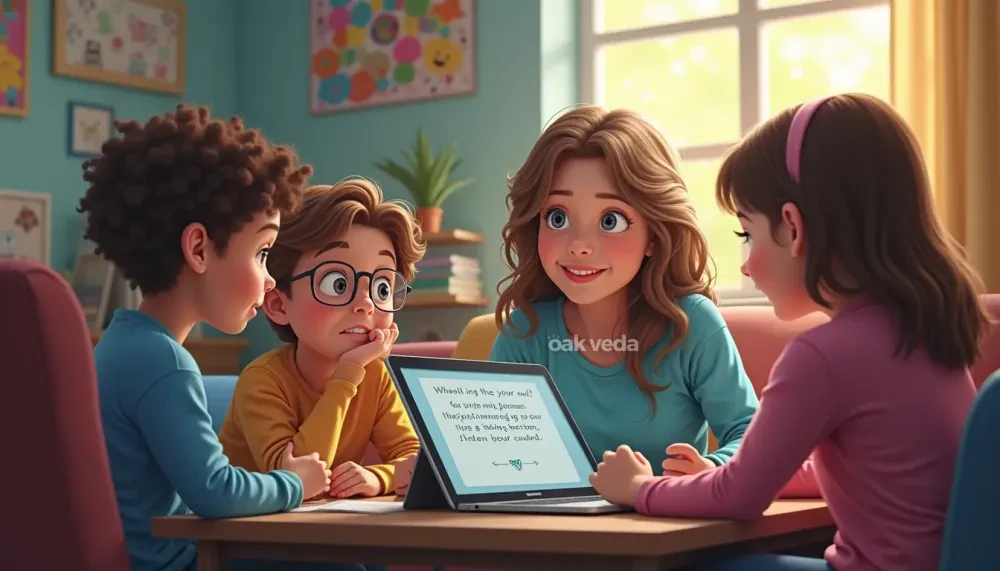
Introduction
Problem-solving is crucial for academic success. When you master effective problem-solving techniques, you unlock the potential to tackle complex assignments and excel in your studies. These skills are not just about finding answers but understanding the process of how to approach challenges systematically.
Key takeaway: By mastering problem-solving techniques, you can significantly enhance your academic performance. This article will guide you through the 5 Best Problem-Solving Techniques for Students to help you navigate academic hurdles with confidence.
Understanding how to solve problems effectively is crucial for students aiming to achieve their educational goals. Let's explore how you can develop these essential skills.
1. Understanding Problem-Solving Techniques
Teaching Problem-Solving Skills
Effective problem-solving starts with students engaging deeply with their assignments. This means going beyond simply completing tasks to understand the underlying concepts and challenges. Strategies for achieving this include:
- Problem-Solving Charts: Visual aids that outline each step of the problem-solving process. These charts guide students through stages such as defining the problem, identifying knowns and unknowns, considering constraints, and reflecting on solutions.
- Revisiting Past Problems: Encouraging students to look back at previous challenges they have tackled. This practice helps them recognize patterns and apply past learned strategies to new problems.
- Documenting Unsuccessful Attempts: Keeping a record of what didn’t work can be just as valuable as noting successful techniques. This documentation fosters a mindset of learning from mistakes and persistence.
- 3 Before Me Rule: A technique where students must consult three classmates before seeking help from the teacher. This encourages peer learning and collaboration, helping students to explore different perspectives.
Methods to Nurture and Develop Problem-Solving Skills in Students

Nurturing problem-solving skills involves creating an environment that promotes critical thinking and hands-on practice. Some methods include:
- Interactive Assignments: Tasks that require active participation rather than passive completion. For example, science experiments, role-playing scenarios in social studies, or real-world math problems.
- Encouraging Critical Thinking: Teaching students to ask questions about their assignments. Questions like “What is the problem I am trying to solve?”, “What information do I have?”, “What do I need to find out?” help in defining the problem clearly.
- Providing Real-Life Contexts: Relating problems to real-world situations makes them more engaging and relevant for students. It helps them see the practical applications of their academic work.
- Regular Practice Sessions: Like any skill, problem-solving improves with regular practice. Setting aside time for dedicated problem-solving activities can significantly enhance these skills over time.
Understanding these foundational aspects of problem-solving sets the stage for mastering specific techniques that can be applied across various academic disciplines.
Principles of Effective Problem Solving
Effective problem solving begins with defining the problem. Clearly identifying what needs to be addressed sets a solid foundation for finding viable solutions. This involves distinguishing between knowns and unknowns, which aids in pinpointing the core issue.
Key principles that guide effective problem solving include:
- Critical Thinking Skills: Engaging deeply with assignments requires honing critical thinking skills. Analyze information, evaluate evidence, and make reasoned judgments to approach problems systematically.
- Structured Methods: Employ structured methods such as the Seven-Step Problem-Solving Process. This method includes stages like identification, analysis, solution generation, planning, implementation, and evaluation.
- Real-Life Contexts: Relating problems to real-life contexts makes them more tangible and easier to solve. Contextualizing issues can provide practical insights into potential solutions.
- Reflection on Solutions: After implementing a solution, reflect on its effectiveness. Assess what worked, what didn’t, and why. This reflection process helps in refining strategies for future problems.
Understanding these principles nurtures your ability to engage effectively with academic tasks. Applying them consistently can transform how you approach challenges and enhance your overall problem-solving capabilities.
You may be interested in:
2. The Five Best Problem-Solving Techniques for Students
1. The 5 Whys Technique
The 5 Whys Technique is a powerful tool used for root cause analysis. It involves asking "why" five times to drill down into the underlying cause of a problem. This method helps students identify issues that might not be immediately apparent, enhancing their problem-solving skills.
How It Works:
- Identify the Problem: Start with a specific issue you are facing.
- Ask Why: Ask why the problem is occurring and write down the answer.
- Repeat: Ask "why" again based on the previous answer.
- Continue: Repeat this process until you have asked "why" five times, leading you closer to the root cause.
Application in Academic Settings:
- Example: Suppose a student consistently scores low on math tests.
- Why did I score low on my math test? – Because I made several careless errors.
- Why did I make several careless errors? – Because I was rushing through the problems.
- Why was I rushing through the problems? – Because I started studying late and didn't manage my time well.
- Why did I start studying late? – Because I procrastinated and underestimated the time needed to study.
- Why did I procrastinate? – Because I find math challenging and tend to avoid it.
Through this technique, the student identifies procrastination as the root cause, allowing them to address this specific issue directly.
2. Visual Representation and Visualization Techniques
Visual aids are crucial for understanding complex problems and generating creative solutions. Techniques like mind mapping, flowcharts, and Venn diagrams help break down information visually.
- Mind Mapping: Helps in brainstorming ideas related to a central theme.
- Flowcharts: Useful for step-by-step process visualization.
- Venn Diagrams: Effective for comparing and contrasting different elements.
3. Breaking Down the Problem Into Manageable Steps
Large problems can often be overwhelming. By breaking them into smaller, more manageable steps, students can tackle them systematically.
Strategies:
- Divide tasks into sub-tasks.
- Set small, achievable goals for each sub-task.
Example: For a research paper:
- Choose a topic
- Conduct preliminary research
- Create an outline
- Write a draft
- Revise and edit
4. Brainstorming and Collaborative Solutions Through Group Discussions
Collaborative brainstorming sessions allow students to generate diverse ideas by leveraging collective thinking.
Benefits:
- Encourages creative thinking
- Promotes teamwork
- Provides multiple perspectives on a problem
5. Estimating and Gut-Checking Potential Answers Through Critical Assessment Techniques
Critical assessment techniques involve evaluating potential solutions before implementation.
Techniques:
- SWOT Analysis: Assess strengths, weaknesses, opportunities, threats of each solution.
- Pros and Cons List: Weighing advantages and disadvantages.
Students refine their ability to estimate outcomes accurately through these methods, ensuring viable solutions are pursued.
By mastering these techniques – from asking "why" to visualizing problems and collaborating with peers – students can significantly enhance their problem-solving capabilities in academic settings.
Visual Representation and Visualization Techniques
Visual aids play a crucial role in problem-solving by making complex issues more understandable and manageable. Visual representation techniques like mind maps, flowcharts, and diagrams help students break down problems into smaller, more digestible parts. These tools allow you to see the relationship between different elements of a problem, making it easier to generate creative solutions.
Techniques for Visualizing Complex Problems:
- Mind Maps: By creating a central idea and branching out into subtopics, mind maps help in identifying issues and organizing thoughts.
- Flowcharts: Useful for outlining processes step-by-step, flowcharts offer a clear visual of how different components interact.
- Diagrams: Venn diagrams or fishbone diagrams (Ishikawa) can aid in root cause analysis by visually representing various factors contributing to an issue.
Using these visual tools enhances your ability to engage deeply with assignments, similar to other methods like the 5 Whys Technique or brainstorming sessions. They are particularly effective when paired with other strategies such as breaking down the problem into manageable steps or collaborative group discussions.
Breaking Down the Problem Into Manageable Steps
Breaking down a problem into manageable steps is a fundamental strategy for effective problem-solving. This approach simplifies complex issues and makes it easier to identify the root cause, facilitating solutions that are both practical and efficient.
Strategies for Breaking Down Larger Problems:
- Divide and Conquer: Split the problem into smaller segments. For instance, if you're tackling a multifaceted math problem, start by isolating each variable or equation.
- Prioritize Tasks: Identify which parts of the problem need immediate attention. By focusing on high-priority tasks first, you can create a manageable workflow.
- Step-by-Step Analysis: Approach each segment methodically. Document each step and ensure you've understood one part before moving on to the next.
Benefits in Academic Tasks:
- Improved Focus: By breaking down the problem, you reduce cognitive overload, allowing for better concentration on individual components.
- Increased Confidence: Tackling smaller tasks builds momentum and confidence, making larger problems seem less daunting.
- Enhanced Understanding: This method promotes a deeper understanding of each part of the problem, leading to more effective solutions.
Breaking down problems aligns closely with techniques like the 5 Whys Technique, where identifying issues at a granular level uncovers root causes. Whether through brainstorming or root cause analysis, simplifying problems fosters an environment conducive to finding creative and efficient solutions.
Brainstorming and Collaborative Solutions Through Group Discussions

Brainstorming is a powerful technique that leverages group discussions to generate diverse ideas and solutions. Engaging in these sessions with peers can be incredibly beneficial for several reasons:
- Diverse Perspectives: When multiple students come together, each brings a unique viewpoint. This diversity helps in identifying issues from different angles, leading to more comprehensive solutions.
- Increased Creativity: Group discussions often spark creativity. One idea can lead to another, creating a chain reaction that results in innovative solutions.
- Enhanced Learning): Collaborating with peers allows students to learn from each other's experiences and knowledge. This shared learning environment can deepen understanding of the problem at hand.
- Effective Problem-Solving: Using techniques such as the "5 Whys Technique" or breaking down the problem into manageable steps can be more effectively applied during group discussions.
To make brainstorming sessions productive, consider these strategies:
- Set Clear Objectives: Define what you aim to achieve from the session.
- Encourage Open Communication: Ensure everyone feels comfortable sharing their ideas without judgment.
- Document Ideas: Use visual aids or charts to track suggestions and identify patterns.
By fostering an environment where students feel free to share and build on each other's ideas, brainstorming becomes an invaluable tool for collaborative problem-solving.
Estimating and Gut-Checking Potential Answers Through Critical Assessment Techniques
Critical assessment of potential solutions is essential in problem-solving. Evaluating the viability of a solution involves several techniques designed to measure its effectiveness before implementation. Here are some strategies you can use:
- Feasibility Analysis: Assess whether the proposed solution is practical and achievable within the given constraints, such as time, resources, and skills.
- SWOT Analysis: Identify the strengths, weaknesses, opportunities, and threats associated with each potential solution. This method helps in understanding the broader impact of implementing a particular approach.
- Cost-Benefit Analysis: Compare the expected benefits of a solution against its costs. This analysis ensures that resources are allocated efficiently and that the benefits outweigh the expenditures.
- Sensitivity Analysis: Evaluate how sensitive your solution is to changes in key assumptions or variables. This technique helps in understanding how robust your solution is under different scenarios.
- Peer Review and Feedback: Present your potential solutions to peers for feedback. Their insights can uncover issues you might have overlooked and provide alternative perspectives that enhance your approach.
- Prototype Testing: Develop a small-scale model or prototype of your solution and test it in a controlled environment. This hands-on method allows you to identify practical issues early on.
By using these techniques, students can critically assess their potential solutions, ensuring they are both viable and effective before full-scale implementation. These methods align well with other problem-solving techniques like the 5 Whys Technique, brainstorming, and breaking down problems into manageable steps, providing a comprehensive toolkit for tackling academic challenges effectively.
3. Additional Strategies for Enhancing Problem-Solving Skills Beyond Techniques
Effective problem-solving goes beyond structured techniques. Incorporating strategies that enhance cognitive function and critical thinking can significantly benefit students.
1. Taking Breaks
Taking breaks is a powerful yet often overlooked strategy. Continuous problem-solving can lead to mental fatigue, diminishing your ability to think clearly and creatively. Short, regular breaks help refresh the mind, improve focus, and boost overall productivity. Techniques such as the Pomodoro Technique, which involves working for 25 minutes followed by a 5-minute break, can be particularly effective.
2. Strategy Games
Strategy games offer another valuable tool for enhancing problem-solving skills. These games challenge players to think critically, plan ahead, and adapt to changing scenarios. Popular options include:
- Chess: Develops strategic thinking and foresight.
- Sudoku: Enhances numerical problem-solving and pattern recognition.
- Escape Rooms: Promotes teamwork and creative thinking under pressure.
Engaging in these activities not only makes learning enjoyable but also strengthens your cognitive abilities, preparing you for complex academic challenges.
Incorporating these additional strategies into your routine complements traditional problem-solving techniques, offering a holistic approach to developing strong problem-solving skills.
4. Tips for Successful Problem Solving in Academic Settings Beyond Techniques
In academic settings, involving the right people in problem-solving discussions can significantly enhance the effectiveness of your solutions. This means selecting team members who bring diverse perspectives and expertise to the table. Whether it's group projects or study groups, having a mix of skills and viewpoints helps generate more comprehensive solutions.
Creating a safe space for open communication is equally essential. An environment where everyone feels comfortable sharing their ideas without fear of judgment encourages creativity and collaboration. Here are some strategies to achieve this:
- Encourage Active Listening: Make sure all voices are heard by actively listening to each member's input.
- Foster Mutual Respect: Establish ground rules that promote respect and equality among participants.
- Promote Constructive Feedback: Encourage feedback that is helpful and aimed at improvement rather than criticism.
These elements ensure that discussions are productive and inclusive, leading to better problem-solving outcomes.
Incorporating these tips into your academic routine not only improves your problem-solving skills but also enhances team dynamics and collaborative efforts.
Conclusion
Mastering problem-solving techniques for students is a journey, not a destination. Regular practice of these strategies can dramatically enhance your academic performance. Embrace patience, persistence, and structured methods tailored to real-life contexts.
Remember:
- Problem-solving is not just about finding quick fixes but understanding the underlying causes and developing sustainable solutions.
- Continuous learning and adaptation are key. Reflect on your experiences, learn from unsuccessful attempts, and keep refining your approach.
Start implementing these 5 Best Problem-Solving Techniques for Students today to excel academically! Your dedication to improving these skills will pave the way for academic success and beyond.
FAQs (Frequently Asked Questions)
What are the key principles of effective problem-solving for students?
Key principles include clearly defining the problem, employing critical thinking skills, engaging deeply with assignments, and nurturing problem-solving abilities. Students should understand the knowns and unknowns in a situation and reflect on solutions after implementation.
How does the 5 Whys Technique help in problem-solving?
The 5 Whys Technique assists students in identifying root causes of problems by encouraging them to ask 'why' multiple times until they reach the fundamental issue. This method is particularly useful in academic settings for breaking down complex challenges.
What role do visual aids play in enhancing problem-solving skills?
Visual aids are crucial in problem-solving as they help students visualize complex problems and generate creative solutions. Techniques like diagrams and charts can simplify information, making it easier to understand and tackle issues effectively.
What strategies can students use to break down larger problems?
Students can simplify larger problems by breaking them into smaller, manageable parts. This approach not only makes the task less daunting but also allows for a more focused analysis of each segment, leading to clearer solutions.
How can collaboration through brainstorming improve problem-solving?
Collaborative brainstorming sessions allow students to share diverse ideas and perspectives, fostering innovative solutions. Engaging peers in discussions encourages collective thinking, which can lead to more effective outcomes than working alone.
What additional strategies can enhance problem-solving skills beyond specific techniques?
Taking breaks can significantly enhance cognitive function during problem-solving tasks. Additionally, engaging in strategy games can improve critical thinking skills, providing a fun way for students to develop their analytical abilities.

